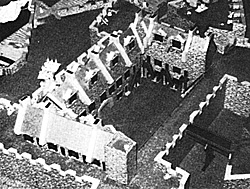 Fort Ticonderoga, called Fort Carillon by the French,
was a key element in the string of fortresses built by the
French to defend their possessions in Canada. Well
placed to defend the western approaches to Quebec and
to serve as a base for raids against the settlements of
New York and New England, Fort Carillon (Ticonderoga)
was destined to play an important part in the struggle
between France and Britain for the control of North America.
Fort Ticonderoga, called Fort Carillon by the French,
was a key element in the string of fortresses built by the
French to defend their possessions in Canada. Well
placed to defend the western approaches to Quebec and
to serve as a base for raids against the settlements of
New York and New England, Fort Carillon (Ticonderoga)
was destined to play an important part in the struggle
between France and Britain for the control of North America.
The governor-general of New France ordered the contruction of Fort Carillon in 1755. The fort was to be built under the direction of the Marquis de Lotbiere, an engineer officer who had neither built nor served in a fortress before. However, despite his inexperience and the difficulties inherent in building a fortress in a wilderness in the middle of a war, de Lotbiere, with the labor of 2,000 French soldiers, succeeded in building a fort on the peninsula between the outlet of Lake George and the waters of Lake Champlain.
In 1757 Fort Carillon was a largely stone structure containing three barracks, a powder magazine, a blacksmith shop, a small armory, and over 100 pieces of artillery of various types and sizes.
First Combats
The first combat operations in the area of Fort Carillon took place in January of 1757 when Captain Robert Rogers and 73 men of his ranger company raided the country just south of Carillon. In March of that year Rigaud Vaudreuil gathered 1,500 regulars, Canadians, and Indians at Carillon. He marched them to Fort William Henry and destroyed that fort's outlying buildings and the boats in the river which had been collected for the coming spring campaign.
In the spring Montcalm prepared to campaign against Forts William Henry and Edward. Once again Fort Carillon served as the gathering point for the French army; 2,570 men of the regular regiments Royal Roussillon, Languedoc, Guyenne, Beam, La Reine, and La Sarre; 524 men of the troupes de la marine; 188 artillerymen; 2,946 Canadians; and 1,799 Indians. Fort William Henry was captured and razed, but instead of continuing on against Fort Edward, Montcalm returned to Carillon.
In 1758 the British greatly increased the size of the army and fleet in North America and prepared a two-prong offensive against Canada. The western prong of the attack, directed against Fort Carillon and Crown Point, was entrusted to Abercromby and an army of 6,300 regulars and 5.900 provincials.
At Carillon Montcalm, with 3,000 men, prepared a flimsy defensive work across the base of the peninsula containing the fort. When Abercromby arrived he ordered a frontal assault against these works without bothering to make a personal reconnaissance or bringing up his artillery to support the assault. The British infantry attacked with dogged courage but were driven back time and again. At sunset Abercromby called off the attack. The British had suffered 1,950 casualties, the French 377. Abercromby admitted defeat and retreated.
The French were not able to follow up this victory in any force but, as the two previous years, they continued to send out raiding forces of varying size from Fort Carillon to harry the British settlements and disrupt the supply lines of the British army.
In 1759 the British advanced again. Because of defeats on the eastern theater the previous year the French did not try to defend Carillon. When the British army under Amherst arrived they blew up the fort. The British halted and began rebuilding the fort, now renamed Ticonderoga. In 1760 Fort Ticonderoga was the staging area for the British forces under Haviland which formed one prong of a three-prong attack against Montreal. The attack was successful and the British conquest of Canada was complete.
A campaign involving Fort Ticonderoga should offer many possibilities to the wargamer. Besides the large battles of 1 757 and 1 758, there are the raids organized by both sides. Consider the possibilities of Rigaud Vaudreuil's attack against Fort William Henry, or the "Battle on Snowshoes" between Rogers Rangers and a force of French regulars and Canadian volunteers. The potential for small scale set peice battles and skirmishing games is vast.
KEN BUNGER COMMENTS
Mr. Nelson has modelled a truly beautiful 25mm scale Fort Ticonderoga. The actual Fort Ticonderoga still stands intact in upper New York State. It has been preserved by a private foundation and is a very popular tourist attraction. The fort contains a very useful museum including many arms, uniforms and numerous artillery pieces. A daily reenactment of the changing of the guard can also be seen. It's highly recommended as where else can one walk through a massive European style Vauban stone fortress in this country. A mock-up of Fort George is also located a few dozen miles to the south in the Lake George tourist area.
Back to Table of Contents -- Courier Vol. 2 #4
To Courier List of Issues
To MagWeb Master Magazine List
© Copyright 1981 by The Courier Publishing Company.
This article appears in MagWeb (Magazine Web) on the Internet World Wide Web.
Other military history articles and gaming articles are available at http://www.magweb.com